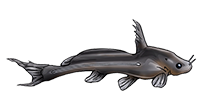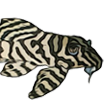Article © Rajanta Sinardja Rahardja, uploaded December 07, 2011.
All images by the author.
The Beginning
After being involved with caring and breeding many Hypancistrus species, my wife, Juliawati, and I wanted to experiment in breeding larger plecos. One of these aspirations was to breed the beautiful L014, Scobinancistrus aureatus. Which is often marketed as the sunshine pleco. L014 is a medium size pleco. It can grow up to 30 cm in length. Although it is not considered to be quite as exotic as some Hypancistrus species, it is nonetheless as beautiful as them.
-

1. Male -

2. Female
We imported 17 adult fish from Germany in December 2008. We keep them in a 960 liter breeding tank aquarium complete with filter unit. L014 is a ferocious eater, thus we need a very good filtration system within the aquarium. We use physical, chemical and biological filtration in the aquarium to keep a constantly zero ammonia level. Ambience and stable temperature are the other important things that we consider in choosing a place to put our breeding tanks. Except for daily maintenance, we keep them in darkness in a room where noises are kept to the minimum. We are lucky because Indonesia has a very low fluctuation of temperature all year round. As for the aquarium decoration, we put some pieces of driftwood in the middle of the breeding tank for the females to take refuge in. We want to keep the harassments from the males to be as low as possible.
Adult Fish
From the 17 adult fish, we chose eight adult fish to populate our breeding tank. We put more than one male because we want to find at least one leading male who can be a good father to the babies. Observing the alpha male's behavior is another important task that we have to do. We do not want the alpha male to only fight with the other males and bully the females without trying to be a father. The next question is how to differentiate between the males and the females (See Picture 1). Males have more squared heads, slimmer body and more odontotes on their pectoral fins. (Picture 2). The females have sharper head shape and fuller body looks with rather smooth pectoral fins
Feeding
There are two components that are important in feeding. The first is the type of food and the second one is the timing of feeding. We use different kinds of food to feed all of our fish (See Picture 3), specifically bloodworms, algae wafers, pellets, and pumpkins. We provide pumpkins to add fiber to their diets. We change the type of foods given to the fish daily. It is necessary for them so they can have more balanced nutritional diet. It is important to feed the fish at regular hours and the right amount. Remember the golden rule: it is better to give less than too much food.
Water Conditions
At the time of breeding, we measured some of the water components:
- pH: 7.5
- Temperature: 28 ° Celcius
- dH: 4
- Dissolved Oxygen: 5
- Ammonia level: 0
-

3. Foods
Cones
Choosing the right caves for the fish is very important because that is the place where the breeding activities will take place. Finding the right dimensions for the cone is the key to pleco breeding success.
Spawning
Our first experience in caring for young L014 started in December 2010. The newly father rejected the eggs from the cone because he was still learning to be the good father. We used methelyne blue to prevent the eggs from developing fungus. I believed that the eggs were around tow to three days after being laid since we could see some shells that protected the eggs were starting to break (See Picture 14). When the babies were able to swim, we moved them to the rearing tank. The first baby food that we gave was baby brineshrimp (artemia). After one month using artemia, we added another kind of food such as small pellet food and crushed algae wafer. We had to measure all the quantity of foods given since too much food can foul the water fast. Too little food will also hinder the growth of the fish. We change 30%-50% of the water of the baby fish every day. The water change won't stress the fish too much while at the same time can promote the faster growth of the fish.
Refuge and Ambience
Hiding places are crucial to the survival of the babies. They will stress and hurt easily when they do not have any place to hide. Well above average territorial behavior exists at an early age. We use hiding places like you see in the picture 15.
-

4. Three days -

5. Four days -

6. Five days -

7. Six days -

8. Eight days -

9. Ten days -

10. Twelve days -

11. Forty five days -

12. Ninety days -

13. Five months -

14. Ten months -

15. Territorial juveniles
Conclusions
For all what I have shared with you today is nothing new. We can find many good articles on the Internet or in books. All we have to do is to learn and adjust the knowledge to the conditions that we have. You may have to experiment with the size of the cones for each species of plecos. That is what we are doing right now. We want to make a cone for a specific species of pleco. We also have to experiment with the type of foods that will make the plecos healthy and can breed well. Behind all of these things that I have talked about, I strongly believe that we, as breeders, should have the passion, the persistence, the patience and, for us, the prayers to realize our aspirations. After all, what we are trying to do is to bring the magic of Nature into our aquariums.
There is further information on this species on the Cat-eLog page.
Back to Shane's World index.




